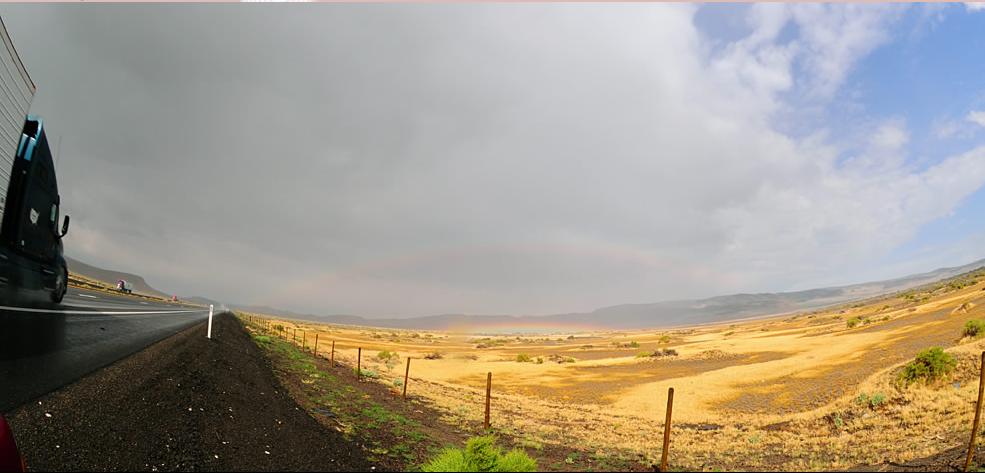Nevada Low Bow
The Nevada Low Bow: A Spectacular Display of Atmospheric Optics
The Nevada Low Bow is a captivating atmospheric optical phenomenon that occurs when rain sweeps across the Nevada desert, creating a primary rainbow that appears just above the horizon. This stunning natural display is enhanced by the presence of a fainter secondary bow hanging low over it. Both bows are centered on the point directly opposite the sun, with the higher the sun being, the lower the bows appear. Interestingly, at sunrise and sunset, the sun and bow centers align perfectly on the horizon, adding to the enchantment of this spectacle.
Understanding the Science Behind the Nevada Low Bow
To fully appreciate the beauty of the Nevada Low Bow, it's essential to understand the scientific principles that give rise to this phenomenon. Rainbows occur when sunlight is refracted, or bent, as it passes through water droplets in the air. This refraction causes the different colors of light to separate, forming the characteristic arc of a rainbow.
In the case of the Nevada Low Bow, the primary rainbow is formed by a single internal reflection of light within the water droplets. The secondary bow, on the other hand, is created by two internal reflections. This results in a fainter and slightly inverted rainbow compared to the primary bow.
Factors Influencing the Appearance of the Nevada Low Bow
Several factors contribute to the unique appearance of the Nevada Low Bow:
-
Sun Position: The position of the sun plays a crucial role in determining the height and visibility of the bows. As the sun rises higher in the sky, the bows appear lower on the horizon.
-
Rainfall Intensity: The intensity of rainfall affects the size and brightness of both bows. Heavier rain showers produce more vibrant rainbows, while lighter drizzles may result in fainter and less defined bows.
-
Droplet Size: The size of water droplets in the air impacts the colors and clarity of the bows. Smaller droplets tend to produce more vivid rainbows, while larger droplets may result in a less distinct display.
The Magic of Sunrise and Sunset
One of the most awe-inspiring moments to witness the Nevada Low Bow is during sunrise and sunset. At these times, the sun and bow centers align perfectly on the horizon, creating a mesmerizing sight. The warm, golden hues of the rising or setting sun further enhance the colors of the rainbow, painting a breathtaking picture against the Nevada desert backdrop.
Capturing the Nevada Low Bow
Photographing the Nevada Low Bow can be a challenge due to its low position on the horizon and fleeting nature. However, with some preparation and patience, it is possible to capture this extraordinary phenomenon. Here are some tips for photographing the Nevada Low Bow:
- Use a wide-angle lens to capture the entire arc of the rainbow.
- Position yourself at a vantage point that allows for an unobstructed view of the horizon.
- Experiment with different exposure settings to capture the vibrant colors and subtle details.
- Consider incorporating interesting foreground elements to add depth and context to your images.
Other Atmospheric Optics Phenomena
The Nevada Low Bow is just one example of the many fascinating atmospheric optics phenomena that can occur in our skies. Here are a few other noteworthy occurrences:
-
Sundogs: These are bright spots of light that appear on either side of the sun, often accompanied by a halo. Sundogs are caused by the refraction of sunlight through ice crystals in the atmosphere.
-
Halos: Halos are luminous circles or arcs that encircle the sun or moon. They are formed when light is refracted by ice crystals in high-level cirrus clouds.
-
Cloud Iridescence: Cloud iridescence is a stunning display of vibrant colors within clouds. It is caused by the diffraction of sunlight as it interacts with tiny water droplets or ice crystals in the cloud.
-
Sun Pillars: Sun pillars are vertical columns of light that appear above or below the sun. They are formed when light reflects off ice crystals in the atmosphere.
The Beauty of Nature's Optical Wonders
The Nevada Low Bow is a remarkable example of the beauty and complexity of atmospheric optics. From rainbows to sundogs, these natural phenomena remind us of the intricate interplay between light, water, and the atmosphere. Whether you're fortunate enough to witness the Nevada Low Bow firsthand or simply marvel at photographs, take a moment to appreciate the wonders that nature can create in our skies.

Rainbows on the ground. Judy Mosby took this on May 28 '08 at Fernley Sink, NE of Fernley, Nevada. ©Judy Mosby, shown with permission.

Rain sweeps across the Nevada desert and a primary rainbow (red on the outside) is only just above the horizon. A fainter secondary bow (red on inside) hangs low over it. Both bows are centered on the point directly opposite the sun and the higher the sun the lower are the bows. At sunrise and sunset the sun and bow centers are both on the horizon.
Note: this article has been automatically converted from the old site and may not appear as intended. You can find the original article here.
Reference Atmospheric Optics
If you use any of the definitions, information, or data presented on Atmospheric Optics, please copy the link or reference below to properly credit us as the reference source. Thank you!
-
<a href="https://atoptics.co.uk/blog/nevada-low-bow/">Nevada Low Bow</a>
-
"Nevada Low Bow". Atmospheric Optics. Accessed on April 24, 2024. https://atoptics.co.uk/blog/nevada-low-bow/.
-
"Nevada Low Bow". Atmospheric Optics, https://atoptics.co.uk/blog/nevada-low-bow/. Accessed 24 April, 2024
-
Nevada Low Bow. Atmospheric Optics. Retrieved from https://atoptics.co.uk/blog/nevada-low-bow/.